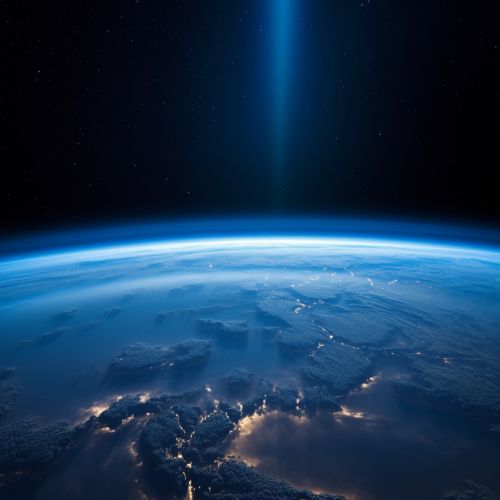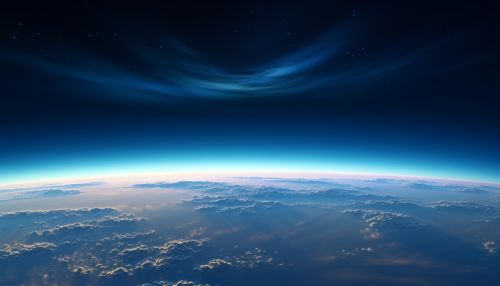Stratosphere
Overview
The stratosphere is the second major layer of Earth's atmosphere, lying above the troposphere, and below the mesosphere. It is stratified in temperature, with warmer layers higher up and cooler layers farther down. This is in contrast to the troposphere near the Earth's surface, which is cooler higher up and warmer farther down.


Structure and Composition
The stratosphere is situated between about 10 km (6.2 miles) and 50 km (31 miles) altitude above the Earth's surface, while its thickness varies with season and latitude. It contains the ozone layer, an area of concentrated ozone within the stratosphere that absorbs most of the Sun's ultraviolet (UV) radiation. It is due to the absorption of radiation by ozone and to a lesser extent other gases, that the stratosphere increases in temperature with height. The majority of the atmosphere's ozone is contained in the stratosphere.
The stratosphere is composed of a number of layers, the most well-known being the ozone layer located in the lower stratosphere. Other layers include the stratopause, the boundary with the mesosphere above, and the tropopause, the boundary with the troposphere below. The stratosphere also contains the nacreous clouds layer, which occurs in the lower stratosphere during winter at high latitudes.
Temperature
The temperature in the stratosphere increases with height, which is a result of the absorption of the Sun's radiation by the ozone layer. This temperature inversion contrasts with the troposphere, where temperature decreases with height. The top of the stratosphere, known as the stratopause, is the point where this temperature increase levels off and remains relatively constant with increasing altitude.
Dynamics
The dynamics of the stratosphere are governed by the absorption of solar UV radiation by ozone, which creates thermal gradients and leads to the formation of stratospheric circulation patterns. These patterns, known as the Brewer-Dobson circulation, involve large-scale movements of air, and the transport of chemical compounds, between the troposphere and the stratosphere.
Ozone Layer
The ozone layer is a region of high ozone concentration within the stratosphere. It absorbs most of the Sun's harmful ultraviolet radiation, thus protecting life on Earth. However, human activities have caused significant ozone depletion, leading to a thinning of the ozone layer, most notably resulting in the annual occurrence of the so-called "ozone hole" over Antarctica.
Stratospheric Clouds
There are two main types of clouds that can form in the stratosphere: nacreous clouds and polar stratospheric clouds. Nacreous clouds, also known as mother-of-pearl clouds, are rare but once seen are never forgotten because of their brilliant iridescent colors. Polar stratospheric clouds are similar to nacreous clouds but are formed in the extreme cold of polar winter and are involved in the formation of ozone holes.
Human Influence
Human activities have had a significant impact on the stratosphere, most notably through the depletion of the ozone layer due to the release of chlorofluorocarbons (CFCs) and other ozone-depleting substances. The Montreal Protocol on Substances that Deplete the Ozone Layer was an international treaty designed to protect the ozone layer by phasing out the production of numerous substances that are responsible for ozone depletion.
